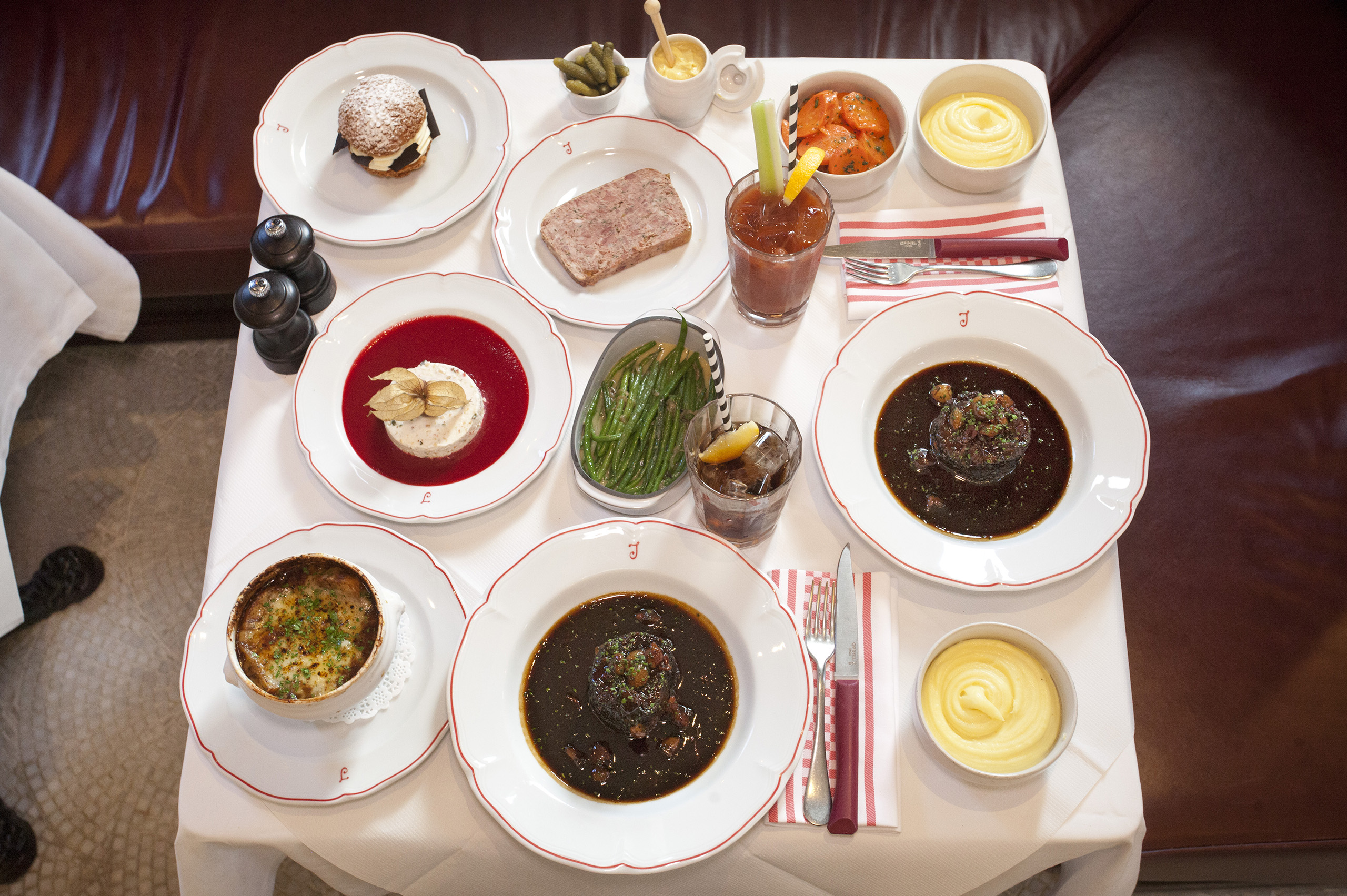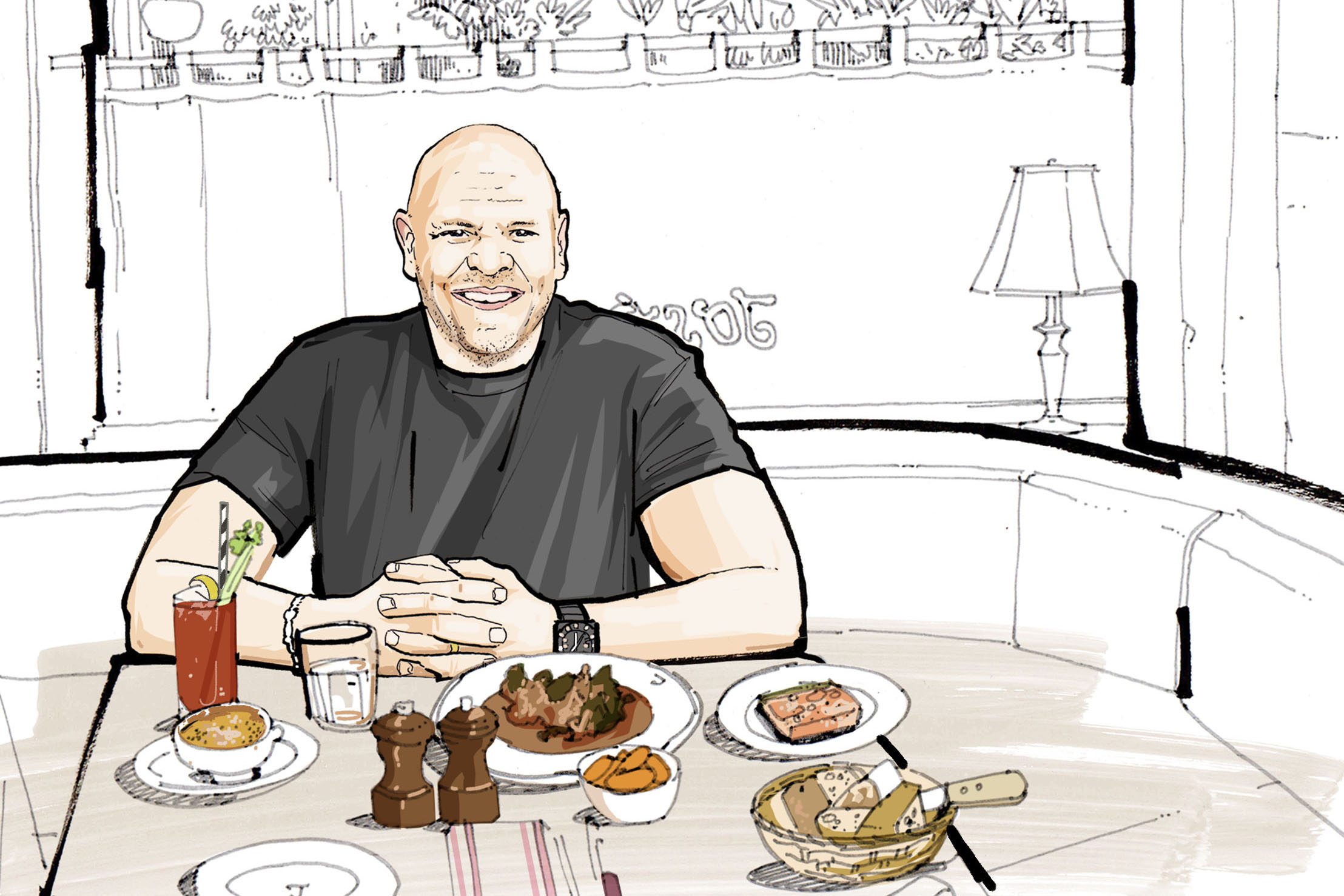Illustration by Lyndon Hayes
The chef Tom Kerridge and I meet at Josephine Bouchon, the west London bistro owned by Claude Bosi of Bibendum. I arrive early. Kerridge arrives promptly at 2pm, our allotted meeting time, and slips into a corner table so small that our knees clash beneath the white linen. Kerridge is a big man. A month ago, he sat at this same table with his chef pals Heston Blumenthal and Sat Bains, and I briefly consider the three men here together and worry for their shins. Looking around now, Kerridge seems to approve. At lunchtime on a Wednesday the restaurant is full: loud and lively, its staff pleasingly busy. It is, Kerridge says, what a day’s first service should be.
Josephine was Kerridge’s choice. “It’s a perfect restaurant,” he says. He points at the other customers and at the bar, and then at the menu. “Simple food. A celebration of produce … and Claude’s a friend.” Kerridge and Bosi met 20 years ago. They are godparents to each other’s children and holiday together. (They also co-own a racehorse.)
I ask what he recommends. When a chef as successful and well loved as Kerridge describes a restaurant as “perfect”, you take note.
“The French onion soup,” he says. “The leek vinaigrette – super tasty. The terrine. The souffle. The sweetbread …” He is at this point just reading from the menu.
Kerridge runs several of his own places, notably the Hand & Flowers in Marlow, his two-Michelin-starred pub. He also records a podcast, appears regularly on television, and publishes books, including, most recently, one about barbecue.
Kerridge is no longer ever present in his own kitchens – he is too busy running a kind of culinary empire. “You speak to every chef my age, we miss it,” he says. “Sometimes you long for the day of being a chef de partie” – head of a section – “when all you have to worry about is making sure the duck breast isn’t overcooked. But you can’t be 51 years old, a head chef, a restaurateur, without thinking about the business situation. What happens when a chef has a nan in hospital? Or a dishwasher breaks? What about when you’ve got fish on the specials at lunchtime and it’s quarter to 12 and it’s still not here?”
Still, there are few greater feelings for Kerridge than those experienced during a service. The chaos and pressure. The camaraderie. The connection between staff and patrons. He points to three servers talking near a staircase that descends to the kitchen. “It’s hard work while you’re doing it,” he says. “But that sense of teamwork, of building respect, of being a part of that …” He seems briefly awestruck. “And you get that twice a day? Lunch and dinner?”
A server approaches. Kerridge orders the terrine to start and the beef bourguignon from a list of specials. I second the bourguignon and begin with the soup, which arrives topped with a roof of melted cheese. The terrine, Kerridge says cheerfully, reminds him of his childhood – of his first tastes of supermarket paté, which he means as a compliment.
I wasn’t naughty but I liked hanging around with the naughty boys
Kerridge grew up on Gloucester council estates. His father was absent – he died when Kerridge was 19 – and Kerridge and his brother were looked after by their mother, who worked several jobs. He describes himself as a latchkey kid. Dinner would be waiting for him when he returned from school, but his mother would not. There wasn’t much money. Still, every Sunday his mother would cook a roast. Instead of meat, which was expensive, she roasted substitute sausage that came from a tube, and paired it with vegetables. Kerridge knew that, despite the family’s situation, he could invite friends round to eat and they would be accepted by his mother. “That hard work of making a guest feel welcome is something, I think, you inherit,” he says.
He left school at 15. He wasn’t a naughty kid, “but I liked hanging around with the naughty boys”. At 18, he applied for culinary school and immediately fell in love with kitchens, which were filled with “a hodgepodge of people”, a staff built irrespective of race or sexuality or economic background, many of them neurodiverse. Here, he discovered a “hugely whirring, electric kind of energy”.
When Kerridge was young, his mother would say, “Do whatever you want to do, but do it the best you can.” He has thought of this as a rule for life – “push yourself a bit more” – an approach helpful when, in 2005, he and his wife, the sculptor Beth Cullen Kerridge, took on the lease for the Hand & Flowers. Kerridge was 31 at the time. He had worked in Michelin-starred restaurants, but he “wanted to cook great food in a space I could feel comfortable in, where there was noise”. At the Hand & Flowers, the ceilings were perilously low, the staff were loud, waiters served food in jeans and trainers. But people came. The pub earned its first Michelin star within a year of opening. Its second, awarded in 2012, made the Hand & Flowers the first pub anywhere to receive two stars.
The bourguignon arrives, with mashed potato and vegetables in separate dishes, and talk turns to the pressure of maintaining high standards. In the six months after the Hand & Flowers received its second star, the pub seemed at odds with what some visitors thought of as a two-Michelin-starred restaurant. “There isn’t a sommelier!” Kerridge would say. “It’s a pub!” He pushed on regardless.
“What a day,” Kerridge says, buoyed. “What an amazing day.”
I ask what worries him about the restaurant industry now. He makes a list. Employer national insurance contributions have risen. So have business rates, the cost of quality produce and utility bills. Kerridge is a lifelong Labour voter and seems broadly supportive of its policies. But, still, all of these things have made it difficult to run a very good restaurant successfully.

He considers Josephine for a while. Who knows, he says, looking around, if it is making any money, despite its busy-ness. Then he seems suddenly curious.
“How many have you got today?” he asks a passing server. “Seventy five?”
The server nods.
“So, at the end of the day, that’s 150 covers?” Kerridge asks.
“160,” the server says.
Puddings arrive: nougat glace for Kerridge, choux a la creme chantilly for me.
I ask if, given his competitive nature, he has ever been motivated by the success of other chefs. He says yes, but in specific ways. The other day, while on holiday with Bains, the pair found themselves in a cryo-chamber, “and Sat’s in there for 30 seconds at -110 degrees, which means I had to sit at the same temperature, because otherwise I’d never hear the end of it”. When, in his 30s, Kerridge began drinking to excess as a release from kitchen pressure, he recalls thinking, “‘If I’m going to do something, I’m going to do it the best I can.’ Even with drinking. And I was amazing at it.” (He has been sober for 11 years; today he orders a virgin bloody mary.)
But Kerridge has never compared his work to others. He points around, considering an explanation. “Josephine is doing 160 covers a day,” he says. “But somewhere around the corner – let’s say the Ivy – is doing 400. Claude’s not comparing himself to that. He’s just getting on with what he does.”
He goes on: “You asked me what I think is good here and I said the soup, because I know it will taste delicious every time, and there will be guests who come here once a week, and every time they will have the soup, and it will be consistently good.” This, Kerridge says, is the challenge of any great restaurant. “Chaotic kitchens don’t operate to the highest standards. But chaos within the controlled kitchen? That’s where you find the sweet spot.” OFM
The BBQ Book by Tom Kerridge (Bloomsbury, £25) is out now. Order at observershop.co.uk to receive a special 20% launch offer. Delivery charges may apply
Josephine Bouchon, 315 Fulham Road, London SW10; josephinebistro.com
